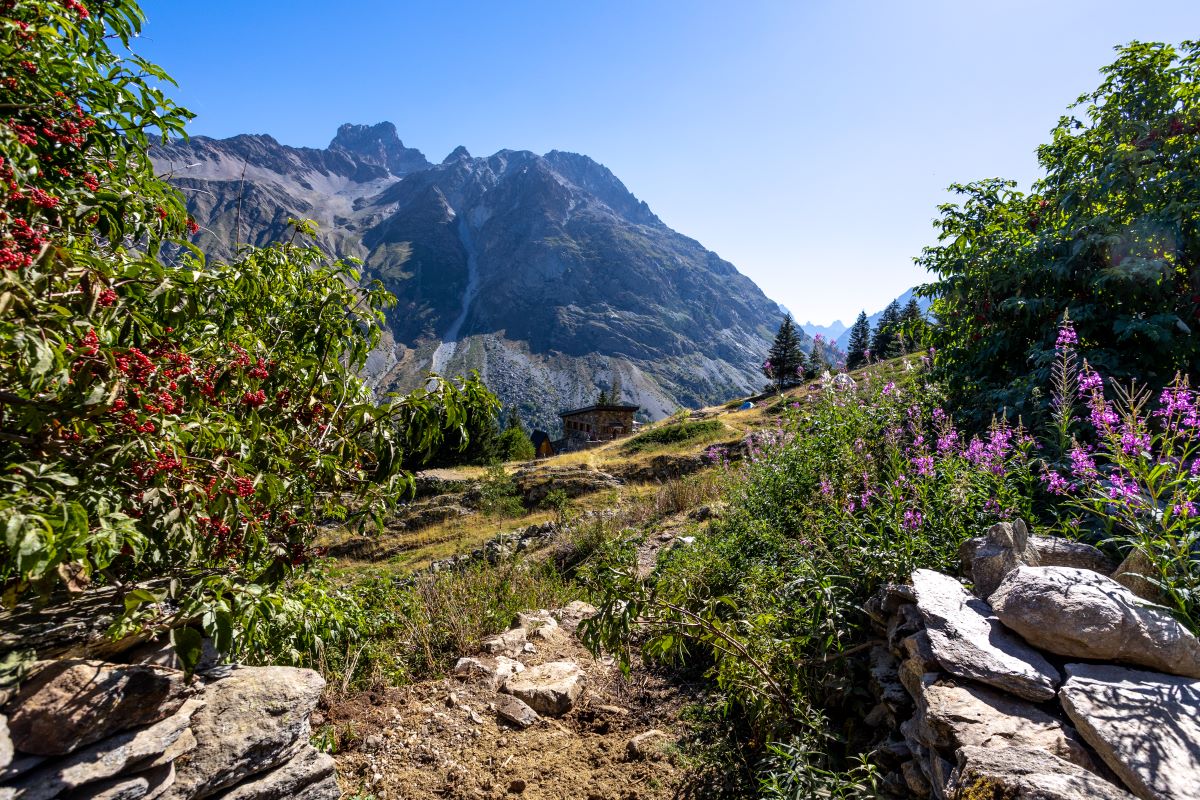
Travers des lacs par l'Alpe du Pin - Mountainside crossing between the lakes via the Alpe du Pin refuge
Description
- From the car park in Les Granges, take the path signposted« Refuge de l'Alpe du Pin ». Drop down below the hamlet and then cross the small stone bridge spanning the Vénéon (be sure to close the gate behind you).
- Then take the path winding up towards the Cascade de la Froide Pisse waterfall, which could be seen on the right as you climbed uphill. Follow the path until you come to the small Alpe du Pin refuge for a meal and/or refreshment break. Then follow the path signposted « Vallon de la Mariande ». Cross wetlands, heather moors and glacial screes and enjoy a succession of impressive views of the Tête des Fétoules and the Barre des Écrins along the gentle flat area on the mountainside crossing between the lakes, and on to the glacial rock bar of La Mariande.
- Just before climbing up to the rock bar at the intersection, turn left towards Le Clot (Forêt de la Gassaudia). Drop down on the path which twists and turns through the forest until you come to a waterfall, the Cascade de la Mariande.
- Turn left towards Saint Christophe and back along the Vénéon, rising gently uphill. Cross the bridge, again being sure to close the gate behind you, and then carry on up to the car park in Les Granges.
- Departure : Les Granges
- Arrival : Les Granges
- Towns crossed : Saint-Christophe-en-Oisans
8 points of interest

 Water
WaterHydroelectric station
On the right bank of the River Vénéon is a small hydroelectric station. It is called a run-of-the-river station, which means it has no capacity to store water. Water is channelled along a pipe to drive the turbine, which is connected to a generator producing the electricity. There is no dam, so production varies according to the amount of water immediately available, with the maximum amount reached, of course, in spring, when the snow melts.

Rhododendron ferrugineux - PNE  Flora
FloraRhododendron ferrugineum
The rhododendron ferrugineum is a member of the family Ericaceae, like the cranberry, lingonberry and bilberry. It is a bushy shrub, 30 to 100 cm tall and common at altitudes of between 1,400 and 2,500 metres. It retains its leaves all year round. Its leaves are tough, elongated (3 to 5 cm long and 1 to 2 cm across), dark green and glossy on the upper side and yellowish changing to rust on the underside, hence its name "ferrugineum". This particular colouring is due to the presence of russet coloured glands.
In late June to early July, the rhododendron plants are covered in clusters of pink scented flowers which are very attractive to pollinators: it is a bee forage plant.
Just one or two rhododendrons can result in the colonisation of an entire slope.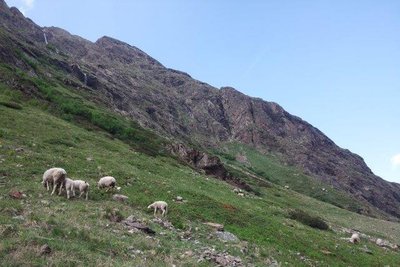
Pastoralisme - PNE  Pastoralism
PastoralismAnimal husbandry in the valley
In summer, some 300 sheep graze the valleys of L'Alpe du Pain and La Mariande.
They are herded up the mountain in early June and brought back down again, lovely and plump, in early October. For four months they are free to roam the high mountain pastures, happily feeding on the rich alpine grass. From time to time, their young owners go up the mountain to tend them. At the end of the season, some linger and it is not unusual to come across them even in late October. They will be gathered by the farmers before the onset of winter.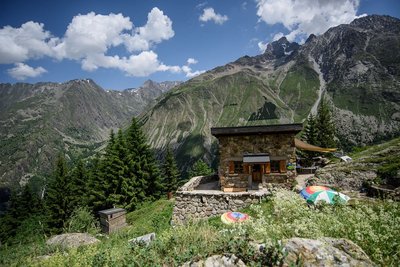
Refuge de l'Alpe du Pin - Parc national des Ecrins - Mireille Coulon  Hut
HutAlpe du Pin Refuge
The Alpe du Pin Refuge is little known and discreet, and stands on the mountain pasture of the same name. It belongs to the Jarrets d'Acier association. It has everything needed to delight the heart, the soul and the calf muscles! Built in 1947, it has preserved its humble origins down the years by making reasonable adaptations to the needs of contemporary comfort. The Alpe du Pin Refuge is located at an altitude of 1,805 m, at the foot of the Tête de Lauranoure (3,325 m), the view of which from St-Christophe leaves no one indifferent. With a capacity of 20 places in a single dormitory, the visitor soon feels at home, and the layout of the refuge helps promote meetings and conversation. You can count on a simple, warm and friendly welcome from the refuge keepers.
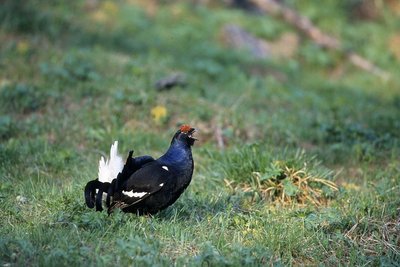
Tétras lyre - Robert Chevalier - PNE  Fauna
FaunaThe habitat of the black grouse
The black grouse is a galliforme (fowl-like) bird and lives at altitudes of between 1,400 and 2,300 metres. It thrives in the semi-open patchwork habitats. These criss-cross habitats of heather moors, grassland and bushes or open woodlands enable it not only to find food for its young (insects, small flowers) in the breeding season (July) but also offers sufficiently tall vegetation cover in which to hide and escape the attention of predators. Song counts are carried out in spring to estimate the number of singing males. Summer counts, using pointer dogs, are also carried out to assess the number of broods in the year.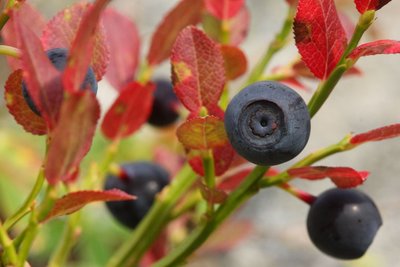
Myrtille commune - Marc Corail  Flora
FloraThe European blueberry
The European blueberry belongs to the Ericaceae family. It is sub-shrub with dense foliage growing 20 to 60 centimetres tall. Its small leaves are supple, alternating, oval and finely toothed. From August, the edible berries with purplish red pulp, hence its popular name gueule noire (meaning black mouth). They turn the slopes of the sub-alpine meadows a beautiful red colour in late summer. It sometimes grows with the bog bilberry (Vaccinium myrtillus) which has white flesh and smooth leaf edges.
The picking of this berry is subject to special regulation. Within the Parc National des Écrins, it is limited to 1 kg per person per day, and the use of comb-type berry pickers is prohibited. In the area covered by the Parc National des Écrins and throughout the Department of Isère: 1 kg per person per day and the use of comb-type berry pickers is prohibited before 15 August.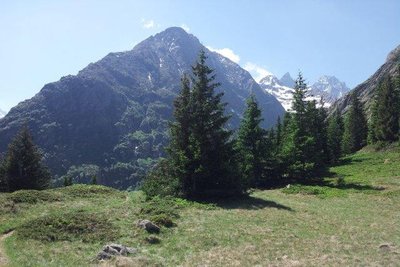
Zone humide - PNE  Flora
FloraWetlands
Wetlands are special habitats characterised by the presence of water - fresh or salt, permanent or temporary. Diverse yet threatened, these environments contribute to shaping the landscapes and constitute an important habitat for numerous animal and plant species. Their conservation is vital if wide biodiversity is to be maintained. High-altitude marshlands or bogs exemplify this.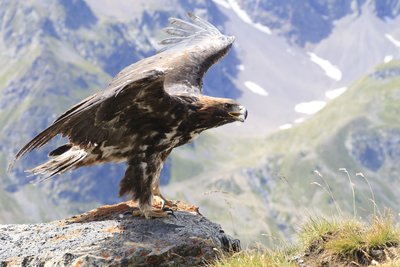
Aigle Royal - Cyril Coursier  Fauna
FaunaThe golden eagle
Once you arrive below the glacial rock bar of La Mariande, you might spot the golden eagle. This majestic bird of prey has dark plumage, the juveniles with beautiful white markings under the wings, soar close to the sunny slopes in order to gain height, looking for prey. It flies alone or with its mate, unlike its cousin, the griffon vulture, which is usually seen in groups. The pair of eagles occupies a large home range, in which several eyries are built. The female usually lays two eggs in the spring. These hatch into eaglets although generally only one will survive. So if you are out walking in late July, keep an eye out - you may be lucky enough to spot a fledged juvenile!
Forecast
Altimetric profile
Sensitive areas
Golden eagle
- Impacted practices:
- Aerial, , Vertical
- Sensitivity periods:
- JanFebMarAprMayJunJulAug
- Contact:
- Parc National des Écrins
Julien Charron
julien.charron@ecrins-parcnational.fr
Recommandations
The loop can be completed in the opposite direction, from the car park in Le Clot.
 In mountain pastures, protection dogs are there to protect the herds from predators (wolves, etc.).
In mountain pastures, protection dogs are there to protect the herds from predators (wolves, etc.).
When I hike I adapt my behavior by going around the herd and pausing for the dog to identify me.
Find out more about the actions to adopt with the article "Protection dogs: a context and actions to adopt".
Tell us about your meeting by answering this survey.
Information desks
Oisans Park house
Rue Gambetta, 38520 Le Bourg d'Oisans
Video presentation of the natural resources of the Oisans mountain and its crafts. Information, documentation about the Park, projections, reading space for children. Accessible to people with reduced mobility. Free admission. All animations of the Park are free unless otherwise stated.
Access and parking
Just before Saint-Christophe, turn right towards Les Granges. Go down the narrow winding road to the car park in Les Granges.
Parking :
Source

Report a problem or an error
If you have found an error on this page or if you have noticed any problems during your hike, please report them to us here:

